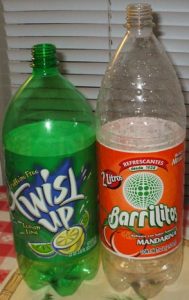Pablo Betancur
Pablo Betancur is an extraordinary teacher in Colombia who takes the time and effort to create hands-on learning experiences for his students. They took the simple launcher principle and designed double and even (at the end) quadruple launchers (everyone has to let go at the same time)!
Multiple Launcher by Mark, Victoria and Lelia Schilke
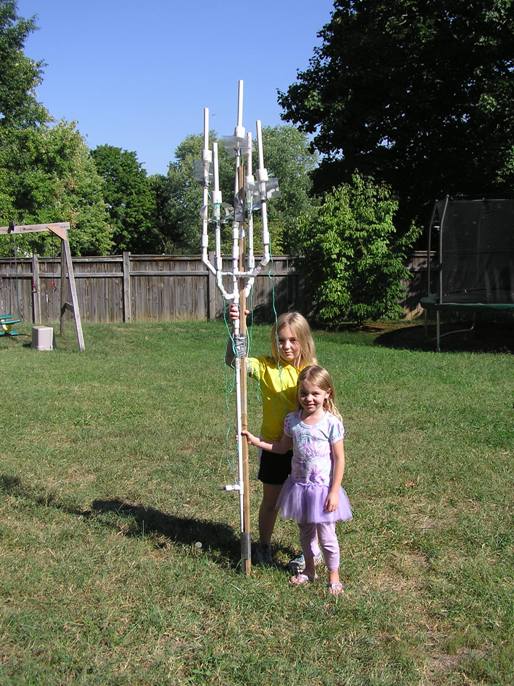
It reminds me of Hydra from Greek mythology--if you cut one off, do two appear in it's place! Brilliant! Note that Small Parts Inc sells a check valve that has worked well for me (to keep water from back washing into a pump with a check valve that didn't work).
Here is Mark's September 2010 e-mail verbatim:
Dear Mr. Harrison:
My daughters Victoria and Lelia (now ages 8 and 5, respectively) very much enjoyed making the water rocket last year. They have used it again and again -- in our backyard, at the park, at a Mensa gathering, at our church picnic, et cetera. Thank you for detailing its construction on your web site!!!
This month, we added a new feature: multiple launch capability. By cutting the main vertical tube and adding two four-way junctions, our launcher now has five branches and somewhat resembles a candelabrum. Rather than depending on perfectly simultaneous trigger fingers, which is virtually impossible to achieve, we added to each branch an in-line check valve that we invented. Each of the two-liter bottles can thusly hold its pressure until its trigger cord is pulled. Without the check valves, the first launch(es) would cause the pressure to be purged from the remaining bottles.
To make the check valves, we spun a 1/2" PVC end cap in a drill press and narrowed its diameter by holding first a rasp and then a piece of coarse sandpaper against the cap's side -- until it was small enough to fit inside a 3/4" PVC coupling. (This step would have been easier on a lathe, but ours is out of commission.) Then we drilled a 5/16" hole in the domed end of the cap so that a Presta valve stem from an old bicycle tube would fit through. A bead of caulk around the base of the valve stem helps seal it to the cap. The skinny Presta valve was left open, and a 3/4"-to-1/2" adapter on the other end allows the big coupling to fit the smaller pipe.
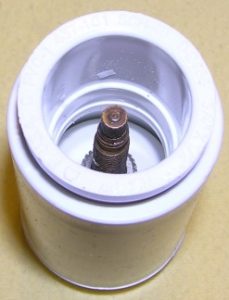
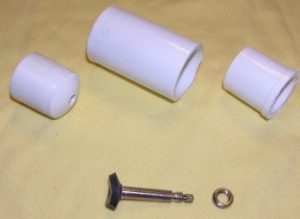
The attached photos show how the check valve pieces fit together and how the finished launcher looks. Note the 1" x 2" stiffener board lashed to the central column. With five bottles loaded and ready for launch, the monstrosity is VERY top heavy. We were too wet from the test launches to take any pictures of it in action, but I'm sure you can imagine the pressurized deluge blasting us from above. By the way, it takes A LOT of pumping for a five-way launch to be ready for lift-off -- but Pascal's Law assures that all bottles get their fair share. For single launches, we added a feature that is not readily apparent from the photo: we can unscrew the center from the four-way branch assembly and use it by itself on the base.
Thank you again for all the great ideas for science projects on your web site!!!
Sincerely, Mark
Tracy Bahr
Here is a clever variation of a launcher which is self-supporting on a sturdy frame, sent by Tracy Bahr of Wisconsin, made for his cub scout pack. It's a little hard to see, but the red arrow points to the valve that the air pumphooks to.
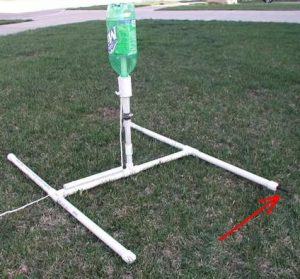
Andrew and Colin Baillie
Andrew Baillie and his son Colin discovered that a common 1 1/4 inch slip joint could substitute for the 1 1/2 inch pipe, saving people from having to buy a whole pipe when they only need 2 inches of it. They also made a frame, and added pressure gages right into their launchers!
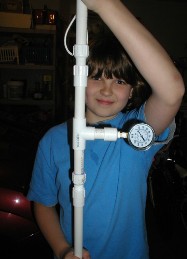
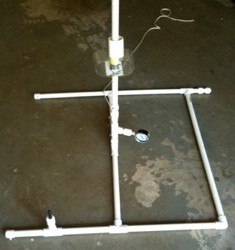
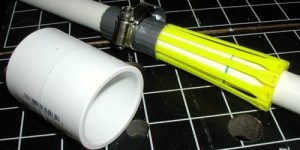
Galen Payne and his son
Galen Payne and his son in Vancouver, WA came up with some interesting innovations. They strengthened the spring with a couple of rubber bands. And, they added an inexpensive PVC slip ball valve to the bottom of the rocket. Here's how he came up with it:
"You might find this funny - The reason we came up with the idea, is because my 8 yo son was curious one day (in the garage of our suburban home) and pumped up the rocket with the compressor. There we were with a loaded rocket in my garage, in a neighborhood of 6000 sq' lots with nowhere safe to launch it. Thank goodness it did not fire, could you imagine that thing going off in the garage? Anyway, we where able to deflate it with the tire valve, but I decided a ball valve would be easier and faster. Galen"
That gave me the idea to shoot paper air rockets like this from the launcher. We had to lengthen the handle to provide the leverage to snap open the valve quickly and add a removable length of pipe at the bottom. But you won't believe how high the rockets launch with all that stored up air pressure. Now I'm trying to design some paper rockets that don't get crunched up when they hit the ground. Then I'll get up some instructions.
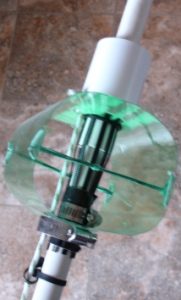
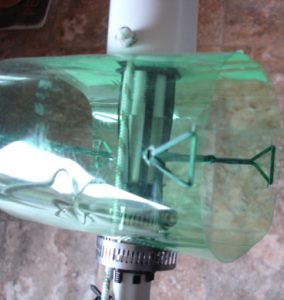
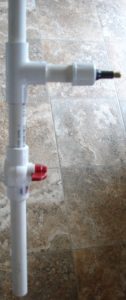
Sealing Variations
People have developed some variations. In particular, if you cannot melt a bump to seal the rocket (maybe you can only find metal pipe that is the correct diameter) they show how to make it with tape. Also a clever way to use a bicycle inner tube for the valve that I had not thought of.
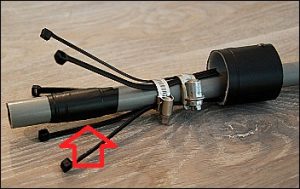
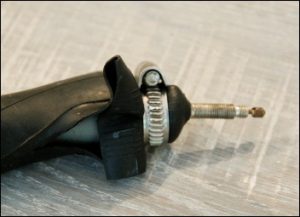
Abhinav
Abhinav in Texas used the hollow case of a pen instead of a bicycle valve and hot glue to hold it in/seal. The footvalve in the pump is what keeps the air from going back out, not the tire valve. If the air pump chuck slips off you might be able so sand around the outside to get a better grip.
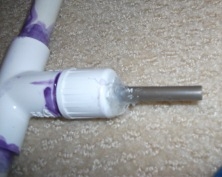
Christopher Bassett
Christopher Bassett shows that PVC pipe is very adaptable to innovations you want to try (125 psi is higher than I would want to be close to).
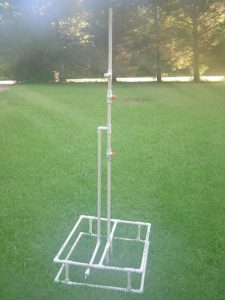
"In the pictures attached, I have my design on a double base. The bottom square puts the weight into the ground and the second square gets the launch tube off the ground. The two center poles touching the ground are mainly for stabilization. The center hole between those two is for water drainage. Near the bottom, to assist the center of gravity, is the compressed air inlet which then elbows up to a T of the launch tube. This is for prevention of water in the air line. The bottom valve is to blow water out the bottom and the top valve is to charge the bottle then shut off so that when the launch is commenced, the compressed air isn't just being released. As well it assists with the reloading. The highest T is for a future pressure gauge so I know for sure when the bottle is fully charged so that I can shut off the air from the tank. The design is set to have the pipe between the two valves at tank pressure. This happens to be 125 psi for me. Lastly, If I were to do it over again I would take Mr. Salvador Robert's advice and thicken the pipes for I have quite a stabilization issue sometimes, especially when I fill the bottle over half full. Thanks again for inspiring me to make a water rocket launcher as well as providing a great base design."
Gary and Dorothy Morse
Gary Morse has found a way to mix water rocket balloon launching with fireworks!
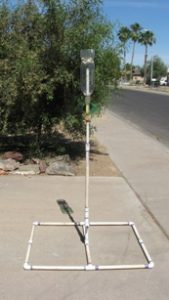
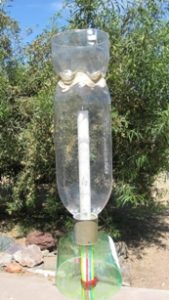
"I wanted to thank you for your inspiration concerning water rocket launchers. This is my 12th one and I finished it an hour ago. I have sent one like it to Germany in kit form and several out of Arizona where I live to other states. I usually launch water balloons, and a lemon sized balloon will travel easily 1/4 mile but I try to send them up at about a 3 degree angle which means they go about 250 - 300 feet away. I found polyurethane glue available at Home Depot in large caulking tubes is perfectly suited for gluing the two bottles together and have shot the same bottle several hundred times. Buying used pvc pipe and fittings on Craigslist has enabled me to build one for around ten dollars. If fireworks are legal in your state they can be taped to the water balloon and lit immediately before launch. The firecracker attached pops in the air making a very interesting rain cloud aprox. 2' dia. Gary and Dorothy Morse "
Daniel Berry
Correspondent Daniel Berry says that a kind of Mexican soda bottle works better than the kind sold in the U.S. I know some serious rocketeers intentionally heat and re-form bottles to be longer, and here it's already done for you.
